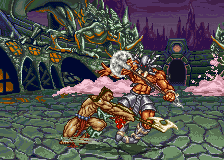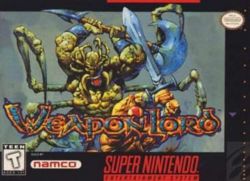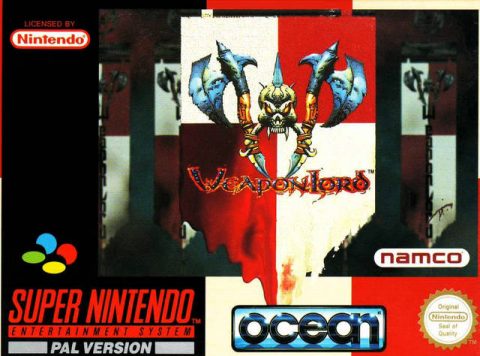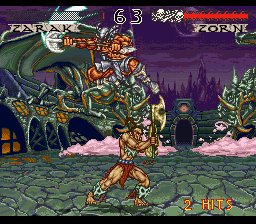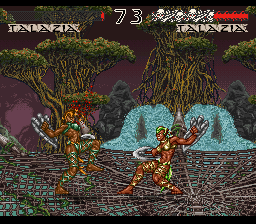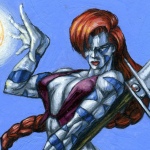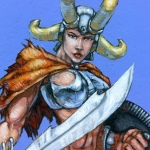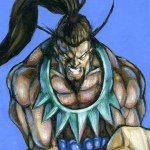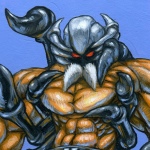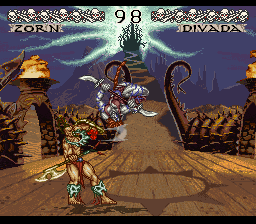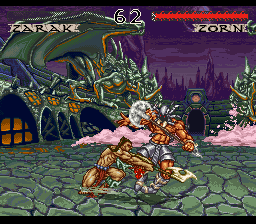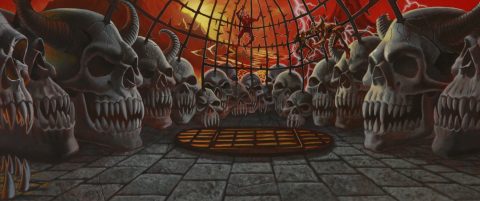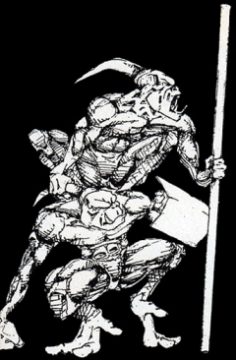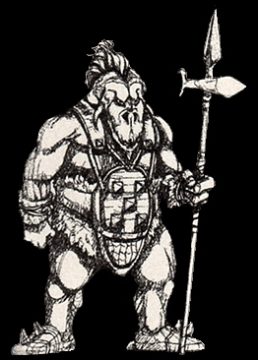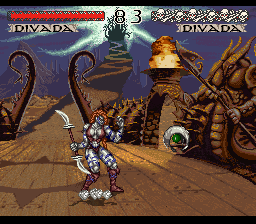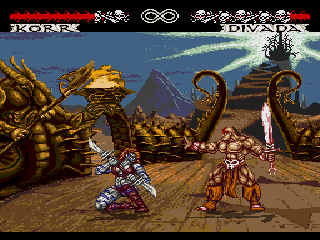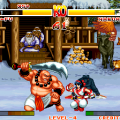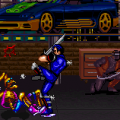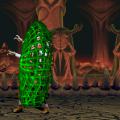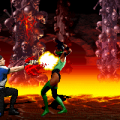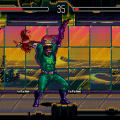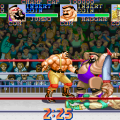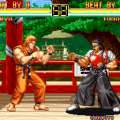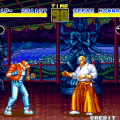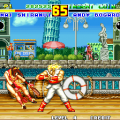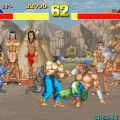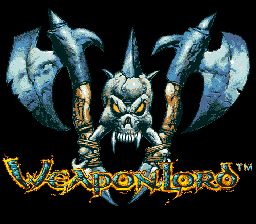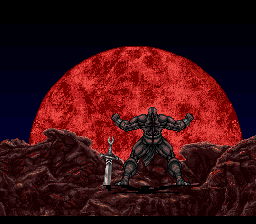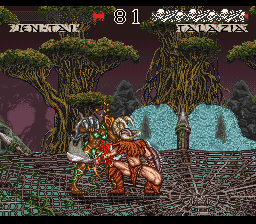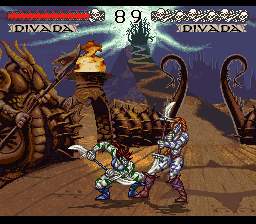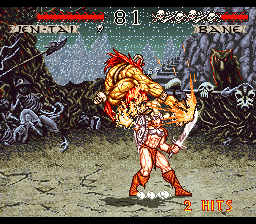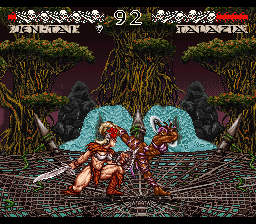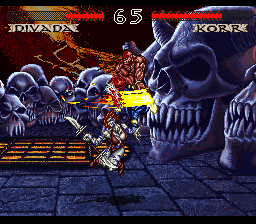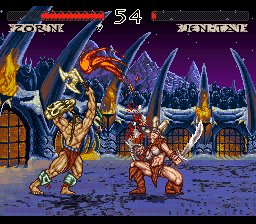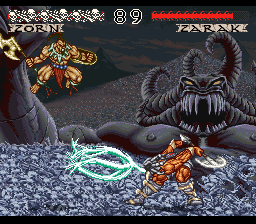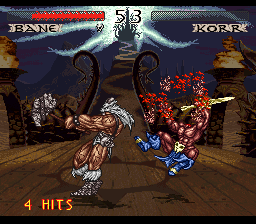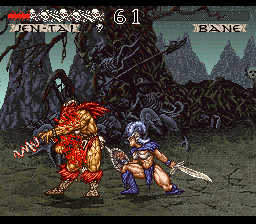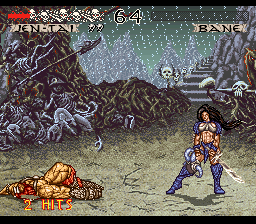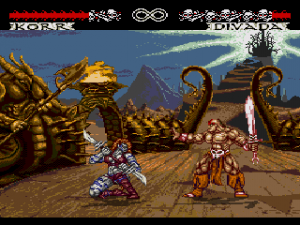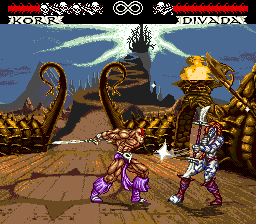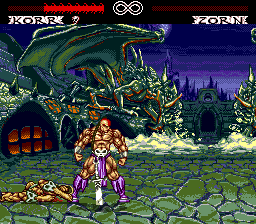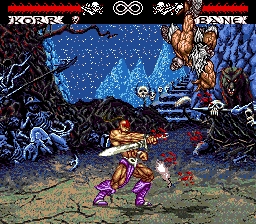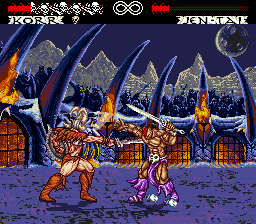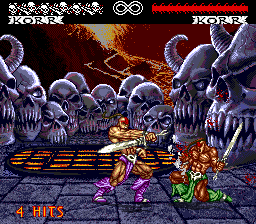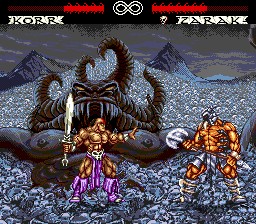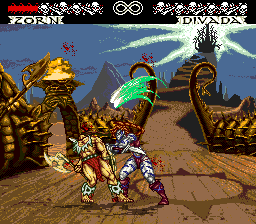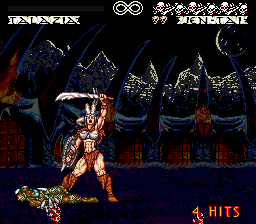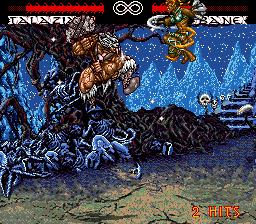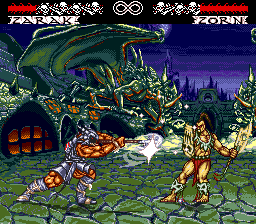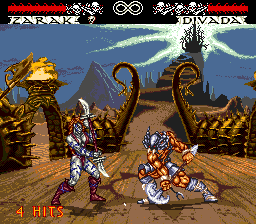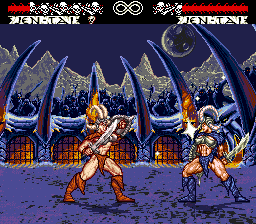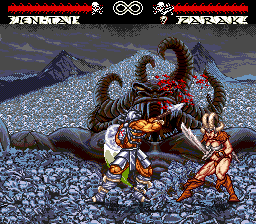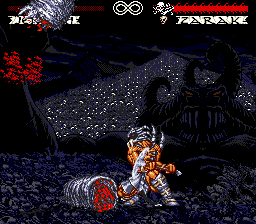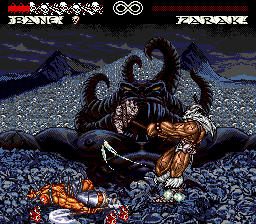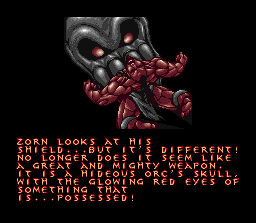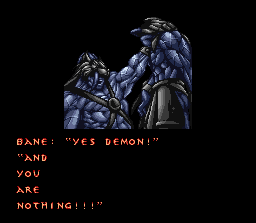As popular as swords and sorcery seems to be among video game developers, there is a surprising lack of Conan the Barbarian-style thematics. There are a few games that flirt with it, but other than the early fighter Barbarian, the Rastan series, and a couple of others, it’s few and far between. WeaponLord is a strong exception. If it wasn’t made with a fondness for Conan, then certainly with a commitment to faithfully replicate the movie’s atmosphere. So expect plenty of roided-to-the-gills muscle men with huge swords, scantily clad (and equally roided-up) women, and loin cloths. There is no lack of overly dramatic wording that seems like those narrations from Conan the Barbarian. This would be embarrassing in any other game, but given the theme, it works quite well and genuinely benefits the game’s presentation.
WeaponLord was published by Namco and developed by Visual Concepts. If that name seems familiar, the studio became part of Sega in the Dreamcast Era was later bought by Take Two, where it was made into 2K Sports. (WeaponLord co-designer Stephen Chiang in the meantime went to the competition at Electronic Arts and got in charge of the EA Sports Line.) Before WeaponLord, Visual Concepts also made Clay Fighter, which plays nothing like it. Amazingly, the WeaponLord project, then still called “Melee”, was initiated by Ken Lobb (Killer Instinct), but he left the team early on. Namco went the extra mile to make this game look nice, so they commissioned British comic book illustrator Simon Bisley to draw the cover and provide other artwork.
The plot in goes like this: Decades into his rule, the Demonlord Zarak is told by a seer that there will be a child born that night beneath a eclipse called the Warrior’s Moon. In adulthood this child will defeat Zarak and end his reign. Rather than simply kill each child born that night and avoid this potential problem, he opts to wait and face his foreseen death. 25 years later the Demon, not afraid to meet his destiny, plans a grand tournament of champions, promising the winner obscene wealth. Six contestants, each born beneath the Warrior’s Moon, emerge to the highest ranks of the tournament on a collision course with destiny.
At first it may seem a bit underwhelming that WeaponLord has only seven playable characters. Most other fighters had a selection of characters in double digits by that time, so it was somewhat disappointing to see the game run with less than half of the roster compared to Super Street Fighter II. Yet the low count allows the characters to be particularly well balanced, and every one of them has a lot more moves than what was standard at the time. There’s also an astounding amount of story presented at the start of the game, as well as in the endings, which goes a long way to pulling you into this savage world of demons and barbarians.
Characters
Korr
A Conan-esque barbarian swordsman in face paint looking for his brother. He wields a huge broad sword, which catches fire during several of his specials.
Divada
A power-hungry sorceress who lives in a desert castle. She enters the tournament to kill Zarak and take over his kingdom. Wields a double bladed weapon.
Bane
A huge man with a wolf mask and horns, who is cursed to stand watch at a place called “Cursed Path”. He is actually Korr’s long lost brother, who had been kidnapped from the tribe in his youth. Carries a giant stone hammer and a claw made of bone.
Jen-Tai
Standing at 6’10”, Jen-Tai serves as Arena Lord for Zarak’s arena. She is reputed to be the greatest warrior in the lands ruled by Zarak and enters his tournament after being challenged by him. Jen-Tai hauls a huge sword and a spiked shield, and wears the most badass helmet ever.
Talazia
After a mysterious “fall from grace” that went with the loss of her memory, Talazia has been adopted by a tribe in the woods. When the tournament is announced, her people believe her to be destined to take on Zarak. She frequently leaps at her opponents from the air, accompanied with a bird-like cry. She fights with a bladed disk and a claw for a shield.
Zorn
Zorn is a warrior thief and one of Zarak’s gladiators. His latest acquisitions are an axe and a shield that looks like a skull that’s not quite dead yet and whose glowing red eyes seem to exert an unhealthy influence over Zorn, who now seeks to kill the Demonlord.
Zarak
The Demonlord and final boss of the game, a demon possessing a mercenary’s corpse and warlord of the world. Even though prophecy has foretold his demise at the hand of the Weaponlord, he is determined to confront his fate in battle. Wears a living helmet that looks like a spider, and wields a giant axe/spear.
What immediately differentiates WeaponLord from most other fighters is its controls. Each character has several specials that are executed with standard Street Fighter II style controller motions, but the devil is in the details. Rather than moving the arrow pad and following it by pushing a button, this method requires the opposite: you move the arrow pad while holding a attack button. I am all for an “onward and upward” attitude in video game design, but it seems like this is strictly for the sake of having the game control differently, and it really does nothing to make things any more intuitive or less difficult. However, it really doesn’t make things any worse, and those who strongly dislike the controls of most fighters might actually prefer this method, whereas to people who play many fighters it might be nothing but awkward. Regardless, you are going to have to relearn fighter controls to play WeaponLord properly.
Most failed/forgotten Street Fighter II cash-ins lack the complexity, in both gameplay and presentation, that fighters from Capcom and SNK had at that time. WeaponLord actually exceeds most of its peers in this regard. The game offers several very advanced techniques, most noteworthy of which is “Thrust Blocking”, a form of advanced blocking. While World Heroes 2 technically already had a form of this, WeaponLord is the first to allow this as a method of defending against every attack, predating even The Last Blade. This technique is executed by holding either of the two least powerful attack buttons and tap a direction corresponding to the level of the attack you are defending against. If executed properly, this causes the opponent to recoil, allowing you to get an easy hit in if you’re quick.
Most other advanced techniques are executed by attacking with moves that have properties causing a specific effect. These techniques are: “Catchers”, which freeze the opponent for a fraction of a second, potentially allowing their weapon to be partially broken; “Deflects” that overpower the opponent’s attack if the two weapons collide; “Openers”, which cancel an opponent’s block; “Take Downs” and “Knock Downs”, which knock them on their back; and “Double Overs”, which cause a opponent to stumble, allowing combos to be extended. You can also attack opponents while they are on the ground, and there is a limitless juggle combo system.
The movesets are also a bit different from most fighters. WeaponLord lacks conventional throws, and instead relies on command throws alone. Rather than huge flashy specials, most advanced attacks are just multi-hit weapon strikes. However, compared to the two or three specials in most contemporary fighting games, characters have a good ten specials each.
Many of WeaponLord‘s unconventional gameplay decisions actually stem from it being the first fighting game to be designed with online multiplayer in mind. WeaponLord was optimized for use with Xband, a then new online multiplayer service that made it possible to play Genesis and SNES games via dial-up internet. However, latency made especially playing fast fighting games quite problematic. After all, the games themselves weren’t intended to be played online at all. So the developers at Visual Concepts took their experiences with playing Street Fighter II and Mortal Kombat through the service, and tried to prevent problems they’ve encountered, basing decisions on timing and balancing on this criterion. As James Goddard told Gamespot:
“Knowing we were going to have a quarter-second lag from New York to California, we realized we couldn’t have any startup frames on our thrust blocks. (…) We also added cross-up protection by designing a rising thrust block that would counter those attacks easily.”
Like countless fighters from the years immediately after Mortal Kombat‘s release, WeaponLord has fatalities. Rather than entering a command to execute them, you have to defeat your opponent with a specific move, or sometimes combo into a specific move after defeating them. Each character has about six fatalities from a shared pool of about eight, with Zarak having an exclusive character specific fatality. It is even possible to combine multiple fatalities. For example, you could disembowel your opponent, decapitate them after they fall to the ground, and then slice open their skull as it flies up in the air to expose their brain. Needless to say, this game is quite gruesome.
WeaponLord‘s graphics are extremely rich with detail. The characters look decent enough if you dig fantasy art, but the backgrounds are fantastic. Each is very attentively, intricately detailed and well-designed. Perhaps the best of which is Zarak’s level, which takes place on a veritable mountain range of skulls. The background is composed of multiple layers, and it gives off a great impression of depth. The music is pretty great as well. It is very atmospheric, consisting largely of pounding drums, and does a great job at setting an appropriate tone for WeaponLord‘s theme.
So WeaponLord definitely feels extraordinarily clumsy at first, which isn’t helped by the immensely overbearing computer opponents. It’s easy to just go ahead and call it a “bad” fighting game, but if it is, it’s definitely the best “bad” fighting game ever made. It should have been just as big a disaster as Clay Fighter, but somehow everything came together into a coherent whole. Yes, it’s way too complex. Yes, it’s totally, utterly, collapsing on itself. The game is being held together with duct tape, and you can see that and “feel” that while you are playing it, but it really does work. If you spend a few minutes with a FAQ to learn the controls, it can become a very enjoyable and satisfying experience to master the game.
WeaponLord was originally intended to be a SNES exclusive, but Visual Concepts began porting it to Genesis while the team was still working on the original version. The Genesis version is aesthetically inferior – it has a black bar behind the status indicators (although the SNES has little black borders on the top and bottom, so the actual viewing field isn’t much smaller), the backgrounds don’t have nearly as many layers, and suffer a bit from the Genesis’ limited color palette. The music is pretty lousy in comparison to the SNES version, and the voices are staticy. On the other hand, those cutbacks also brought with them a noticeable advantage – on the Genesis, the game runs a little more fluently, which improves the overall playability of the game. It also seems like a bit of additional fine tuning went into that version, as it got rid of some oversights in the AI that were easy to exploit on the Nintendo platform. Other than the SNES game, the difficulty spectrum doesn’t range from unforgiving to godlike, either – the easiest level is in fact a fairly easy one, at least in comparison.
Despite its high barrier of entrance and somewhat counter-intuitive mechanics, WeaponLord was received rather well by the press. But the age of the PlayStation had already begun, and sales remained underwhelming. James Goddard and Dave Winstead never managed to convince Namco to do a sequel, and the team eventually dispersed to other ventures. Later when the project leads reunited at CrunchTime Games to make the excellent space shooter Shred Nebula, but that was denied success as well, so plans of trying to buy the WeaponLord IP from Namco and make an HD Director’s Cut fell through. Both Goddard and Winstead were most recently involved with the Killer Instinct reboot on Xbox One (as a combat consultant and character designer, respectively).
Links:
Crunchtime Games – WeaponLord by James Goddard; a bit of cool behind the scenes info.
Gamespy – Interview with Dave Winstead by Sterling McGarvey; covering WeaponLord on page 3 and 4.
Gamespot – Forging WeaponLord by Maxwell McGee; making of with lots of concept art and interviews.
Gemakei Interviews – David Winstead by James Flynn.
Video Game Museum – Endings All of the endings.
Special thanks to Maxwell McGee for sharing his files with us.
